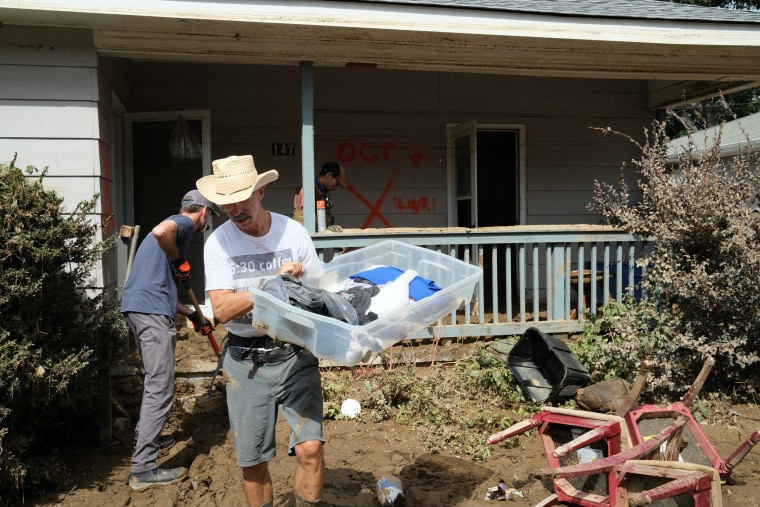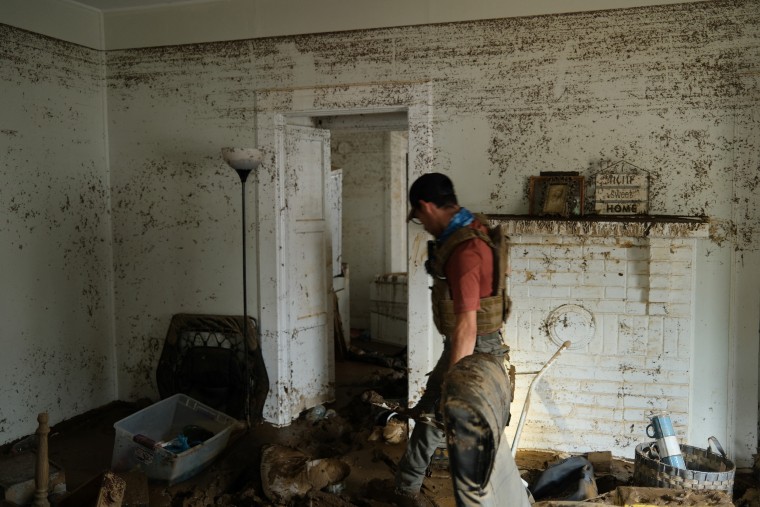ASHEVILLE, N.C. — The deluge came furiously — and shockingly fast.
Speaking from a makeshift shelter at a local technical college here, James Yulon Ferguson recalled this week how he escaped with a friend on Sept. 27 shortly before the rising floodwaters reached the roof of his trailer along the Swannanoa River.
After the storm, when the waters dropped somewhat, Ferguson went back to find that his trailer had been swept into a neighbor’s home nearby. He salvaged some clothes, but his home was lost, he said.
Now, Ferguson, 52, is staying in his third shelter since being displaced and faces the grim prospect of a long, cold winter with nowhere to call home.
“It might take us another year, maybe two or three years, to get another place,” he said. “I don’t know.”
A week after Helene ravaged the hills, hollows and river valleys of western North Carolina, recovery and rescue efforts remained ongoing. Search-and-rescue crews continued to pull bodies from receding floodwaters, wrecked homes and tangled masses of muck, trees and other debris left strewn across battered communities.
Local officials elsewhere continued to sort through hundreds of reports of those still unaccounted for by loved ones following one of the deadliest storms in modern history.
With the death toll still expected to rise, at least 223 people have been confirmed dead. State and local officials say the number of homes destroyed remains an open question.
But as recovery efforts continue, emergency planners and residents here face another daunting challenge that’s likely to endure for weeks to come: where and how to shelter people with lost or damaged homes.
Complicating that problem are ongoing power outages that have left hundreds of thousands of people in the dark and without heat as the calendar wanes toward year’s end.
“We’ve got to have the power back on,” said Mark Pless, a paramedic and a Republican state House representative from Canton, a town of about 4,500 residents some 17 miles west of Asheville. “That’s going to take awhile, and it’s going to get cold before long.”

As of early Friday, more than 230,000 customers remained without power statewide — down from about 1 million at the storm’s peak, said Justin Graney, a spokesperson for North Carolina Emergency Management.
Still, about 100,000 customers in the hardest-hit areas — in parts of Asheville and large swaths of surrounding Buncombe County, as well as in other mountainous parts of the state “with significant infrastructure damage” — will remain without power indefinitely, Duke Energy spokesman Jeff Brooks said.
“It’s going to take extensive rebuilding and extensive periods of time” to restore power to some areas, said Brooks, who noted milelong stretches of damaged or lost transmission lines, dozens of downed power poles and the total destruction of two power substations.
As temperatures begin to drop and the power remains out in those areas, a chief concern is whether there will be enough long-term shelter to help those who need it, said Pless, who chairs the state House’s Disaster Recovery and Homeland Security Committee.
“I don’t know that we’ll be able to do mass sheltering for a long period of time,” he said.
According to the state, at least 23 shelters housing 1,244 people were operating in western North Carolina as of this week, with plans to open additional shelters as needed. Some of those included temporary shelters in schools, churches, gyms and other available spaces.
But local officials say they’re still trying to assess how the numbers of those who need shelter could change — especially with extended power outages likely to force some residents to seek alternative living arrangements.

Even before Helene struck, some of the same communities in the Blue Ridge Mountains hardest hit last week were already grappling with housing issues, said Haywood County Manager Bryant Morehead.
“We’ve had housing problems here for the last few years,” he said. “Covid made it difficult. Tropical Storm Fred made it even worse,” he added, referencing a storm that hit in 2021. “And now here comes Helene.”
On top of that, Morehead said, the recent closing of a paper mill that was the county’s largest employer has further compounded the problem, as people left out of work are struggling to afford rents.
“It’s just another stressor,” he said.
In the fallout from Tropical Storm Fred, Haywood County managed to use some local funding to put people who needed it into long-term shelter from the late summer — when the storm hit — through the end of that year, Morehead said.
But Helene’s havoc is far more widespread, he said.
The sheer devastation could help make communities eligible for Federal Emergency Management Agency grants that weren’t available to them following the lesser destruction of Fred, Morehead noted.

On Friday, the federal agency said in a statement it was encouraging “as many people to apply for help from FEMA as possible,” and noted that it was offering “Serious Needs Assistance” grants for people who are displaced, in need of home repairs or have property losses.
Meanwhile, some residents with homes severely damaged in the storm were making do.
Devonna Brown, 34, a mother of two children whose husband’s auto repair shop in Asheville was lost in the floods, told NBC News this week that her home was extensively damaged by fallen trees, had no water service and likely would be without power for weeks. Still, her family was hunkering down and staying put.
“We’re still at the house,” she said. “We have a generator, and luckily we got some bottled water and my son has an old truck in the yard that kind of filled up its bed with rainwater. That’s what we’re using to flush our toilets.”
But a big question remains just how long residents can hold out before they need to find housing elsewhere.
For now, the focus remains on recovering and rescuing victims, Pless said. But assessing who will need shelter — and for how long — is something “we kind of have to start figuring out,” he said. “We’re going to have to make some decisions here really soon.”
Read the full article here

















